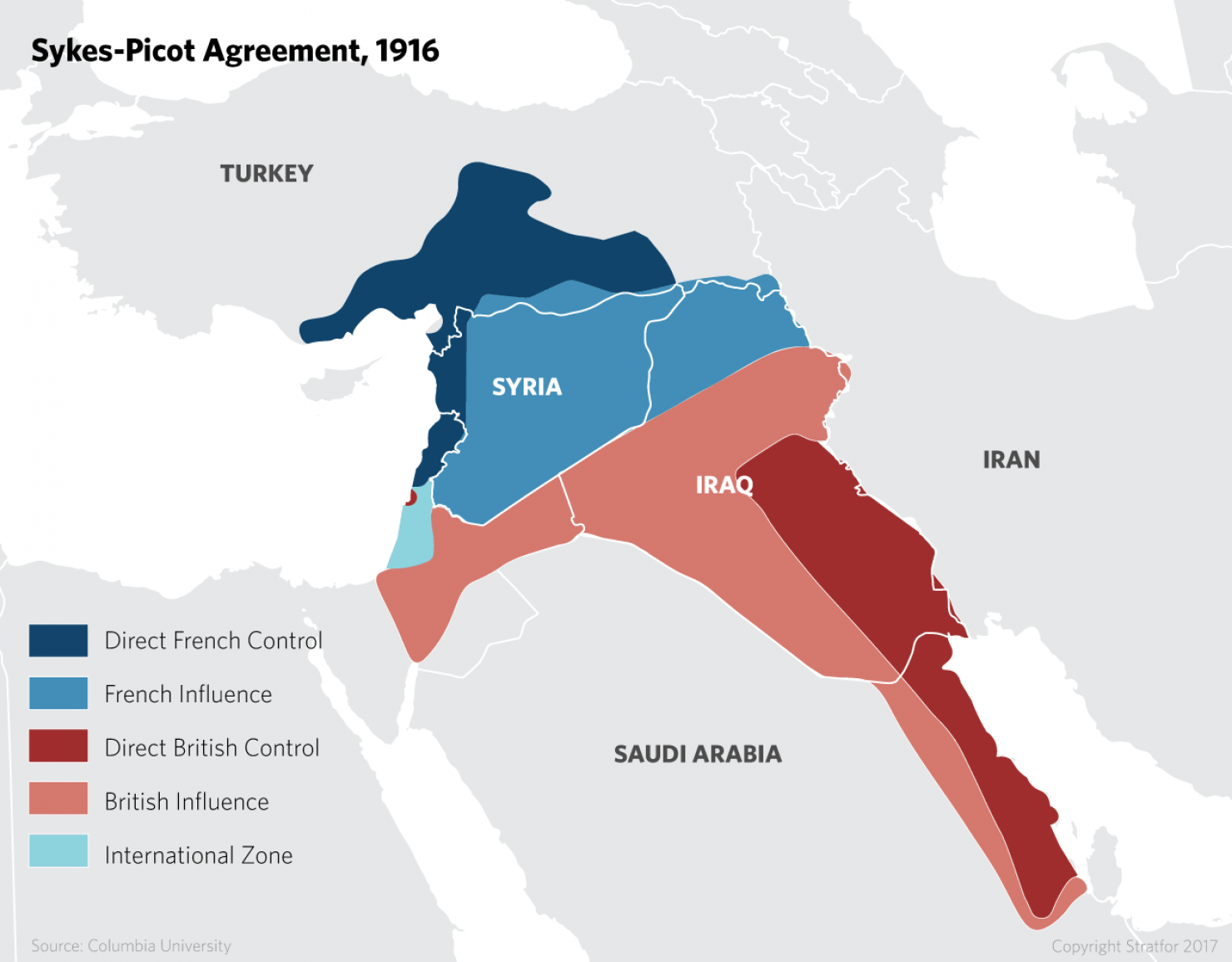More languages
More actions
General-KJ (talk | contribs) (Created the page) Tag: Visual edit |
General-KJ (talk | contribs) (Added map) Tag: Visual edit |
||
| Line 1: | Line 1: | ||
The '''Sykes-Picot Agreement''' was a secret treaty made in 1916 between [[United Kingdom of Great Britain and Northern Ireland|Britain]] and [[French Republic|France]] during the [[First World War]] to divide the territories of the [[Ottoman Empire (1299–1922)|Ottoman Empire]] between themselves when the war was over. The two architects of this treaty, Briton [[Mark Sykes]], and Frenchman [[Francois Georges-Picot]], made this treaty with little regard to what the native peoples of the region wanted, and deliberately betrayed their Arab allies to carve up the region into colonies. Although the Sykes-Picot Agreement would be superseded by the [[Treaty of Sèvres]] made at the [[San Remo conference]] after the war, the artificial lines drawn on a map tearing through ethnic and [[Religion|religious]] communities made by these two [[Imperial core|western]] diplomats would become the basis for the borders of the modern [[Middle East]].<ref name=":0">{{Web citation|newspaper=Al Jezeera|title=A century on: Why Arabs resent Sykes-Picot|url=https://interactive.aljazeera.com/aje/2016/sykes-picot-100-years-middle-east-map/index.html}}</ref> | The '''Sykes-Picot Agreement''' was a secret treaty made in 1916 between [[United Kingdom of Great Britain and Northern Ireland|Britain]] and [[French Republic|France]] during the [[First World War]] to divide the territories of the [[Ottoman Empire (1299–1922)|Ottoman Empire]] between themselves when the war was over. The two architects of this treaty, Briton [[Mark Sykes]], and Frenchman [[Francois Georges-Picot]], made this treaty with little regard to what the native peoples of the region wanted, and deliberately betrayed their Arab allies to carve up the region into colonies. Although the Sykes-Picot Agreement would be superseded by the [[Treaty of Sèvres]] made at the [[San Remo conference]] after the war, the artificial lines drawn on a map tearing through ethnic and [[Religion|religious]] communities made by these two [[Imperial core|western]] diplomats would become the basis for the borders of the modern [[Middle East]].<ref name=":0">{{Web citation|newspaper=Al Jezeera|title=A century on: Why Arabs resent Sykes-Picot|url=https://interactive.aljazeera.com/aje/2016/sykes-picot-100-years-middle-east-map/index.html}}</ref> | ||
[[File:Sykes-Picot Map.png|thumb|Map of the Sykes-Picot agreement|240x240px]] | |||
== Legacy == | == Legacy == | ||
Latest revision as of 12:06, 16 May 2024
The Sykes-Picot Agreement was a secret treaty made in 1916 between Britain and France during the First World War to divide the territories of the Ottoman Empire between themselves when the war was over. The two architects of this treaty, Briton Mark Sykes, and Frenchman Francois Georges-Picot, made this treaty with little regard to what the native peoples of the region wanted, and deliberately betrayed their Arab allies to carve up the region into colonies. Although the Sykes-Picot Agreement would be superseded by the Treaty of Sèvres made at the San Remo conference after the war, the artificial lines drawn on a map tearing through ethnic and religious communities made by these two western diplomats would become the basis for the borders of the modern Middle East.[1]

Legacy[edit | edit source]
In the 100 years since the agreement the Middle East has been one of the most turbulent regions in the world, and many of the conflicts in modern day can be traced back to this imperialist treaty. This treaty is one of many reasons why the native population of this region have good cause to hate the west for its consequences are still being felt in the 21st century.[1]
References[edit | edit source]
- ↑ 1.0 1.1 "A century on: Why Arabs resent Sykes-Picot". Al Jezeera.
